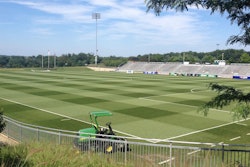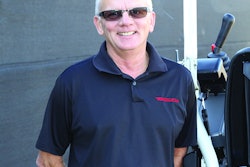Properly outfitting construction equipment for work in winter’s harsh conditions can protect it, lower your total cost of ownership and ensure a safe environment for both employees and machines.
Backhoe loaders
 Case says the “SmartClutch” feature on its backhoes enables the operator to customize the feel of forward-to-reverse transitions to suit his preference.
Case says the “SmartClutch” feature on its backhoes enables the operator to customize the feel of forward-to-reverse transitions to suit his preference.Photo: Case
Backhoe loaders provide great torque, which allows them to handle extreme conditions and heavy, wet snow with ease. They work with a variety of attachments, including blades, sweepers, snow pushes and blowers. Their ability to lift snow into stockpiles and trucks make them an essential snow-removal machine.
Case recommends that owners in northern climates operating throughout the winter select the manufacturer’s cold weather package. Make sure the machine has front auxiliary hydraulics for added attachment versatility.
Some backhoes, such as the new Tier 4 Final N Series, feature a cab-activated quick coupler that allows an operator to switch attachments without leaving the warmth of the cab.
Some manufacturers provide additional features that can be helpful in the winter months. Case backhoes have an adjustable “SmartClutch” feature, which lets operators customize the feel of forward-to-reverse transitions to suit their preference.
This is particularly helpful in snow removal applications where the operator is consistently shifting from forward to reverse. Smoother transitions are generally more comfortable and are ideal in larger parking lots where there are fewer obstacles, whereas a stiffer, more immediate transition may be necessary in more confined spaces and near other vehicles.
“Ride Control” is another important feature for backhoes. If the backhoe is regularly roaded from one parking lot to the next, or if the snow is being carried to a larger stockpile, Ride Control will cushion the movement of the loader arms and provide a smoother ride. (This feature is also available on wheel loaders and skid steers.)
Cab amenities count. With the potential of long hours, a comfortable operator is essential for productive work. For starters, make sure that your machines have an enclosed cab with both heat and air conditioning. A heated seat is an additional feature that helps operators stay comfortable during long shifts. While heat is a no-brainer for working in frigid temperatures, the AC is still important, as it’s essential in eliminating humidity from the cab.
Snow removal is all about visibility – both for the operator and the people around the machine. Look for a backhoe that offers adjustable side lighting for improved visibility and jobsite awareness during nighttime operations.
Wheel loaders and compact wheel loaders
Wheel loaders are multipurpose machines that are great at moving large amounts of snow and ice due to their power, and the added visibility afforded by large floor-to-ceiling windows and a higher vantage point. Wheel loaders can use a variety of attachments, including snowplows and pushes, buckets, snow blowers and even salt dispensers (though it’s not common). Depending on the manufacturer, some compact wheel loaders can share attachments with skid steers for optimal fleet versatility.
Look for heat and heated air-ride seats to help operators stay comfortable inside the cab. Specialty tires are also recommended. Case wheel loaders are available with Michelin SnoPlus tires and heavy-duty axles with a locking front differential for added traction on snowy or icy terrain.
Since snow removal often takes place at night or during a storm where visibility is an issue, look for floor-to-ceiling windows and a low rear hood to help improve sightlines. Also look for optional rearview cameras and additional lights to improve visibility for safer working conditions.
Most manufacturers offer select packages to help keep equipment performing at its best in the winter months. Select Case wheel loaders, for instance, are available with an optional cold weather package and a snow package.
The cold weather package is ideal for machines working in extreme temperatures down to -50 degrees Fahrenheit. It offers 2 HD batteries, low temp Hytran Ultra hydraulic oil, a hydraulic oil cooler bypass, hydraulic heat load valve, an engine block heater, an air-intake grid heater and fuel warmer, heated mirrors, a reversing fan to remove snow accumulation from the radiator, as well as wide fenders and side covers.
The pre-set snow package features six LED working lights for greater visibility during nighttime snow clearing, a cooling system with reversing fan, the choice of Snowplus or L2 radial Michelin tires and a five-speed transmission with lock-up torque converter that improves acceleration and hill climbing for faster cycle times.
Skid steers
Another popular choice for snow removal is the skid steer. Along with their enclosed cabs with heat and heated air-ride seats, these machines can use a variety of attachments, including low-profile buckets, snow pushes, brooms and blades, and standard and high-flow snow blowers.
If you work in a region that encounters lots of snow, you should consider using a radial-lift skid steer over a vertical configuration. Radial lift machines are more proficient in groundwork and digging below grade – movements that relate most directly to snow-removal applications.
Some skid steers on the market can also be outfitted with 1,000-amp cold-cranking batteries and different weight oils that are more conducive to cold weather applications.
Remember to review package offers. Equipment manufacturers offer packages that set up skid steers for optimal winter work.
Before you start thinking about attachments and other cold-weather accessories, make sure that your machine is properly maintained and performing at its best. No matter what types of machines you have in your fleet, you should always check the operator’s manual for recommended winter maintenance practices. Pay close attention to the requirements and recommendations for fuel type, engine and hydraulic oil, air filtration and diesel exhaust fluid systems – failure to do so can result in costly downtime for your machine.
It is also important to follow the manufacturer’s recommendations for cooling systems maintenance. Checking the coolant level regularly, and flushing and replacing the fluid at OEM-specified intervals will keep your cooling system running efficiently all winter.
Keep an eye on your machine’s battery as well. The required current for a cold start can increase up to 200 percent at 0 degrees Fahrenheit, so make sure that your battery is in top condition by checking the electrolyte level and keeping the terminals clean. It is also important to keep your undercarriage free of snow and ice accumulation. We recommend that you inspect the undercarriage every day to prevent damage from mud, ice and debris build-up.
EDITOR’S NOTE: This article was contributed by Case Construction Equipment.









